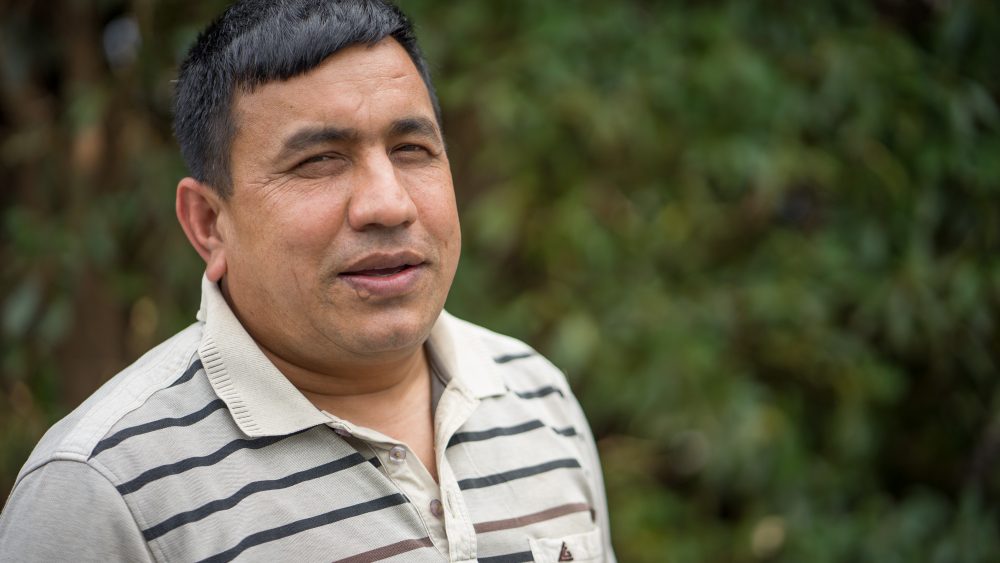Just like the man who was affected with leprosy who asked Jesus to heal him in the gospels, leprosy was “my invitation into the kingdom of the Lord,” says Amar*.
Amar was 10 years old when his family noticed pale patches on his face. His parents, devout Hindus in a remote village in Nepal, took him to see a witchdoctor, who told them his sickness was a judgment and they should sacrifice a goat and a chicken.
“But the witchdoctor couldn’t heal me.”
The patches spread to other parts of his body and Amar began to feel a lot of pain. His parents decided he needed to go to hospital. The Nepalese village where Amar grew up had no roads out. It was a two-day walk to the city hospital. They also could not tell what was wrong with Amar.
It took two years for Amar to be diagnosed with leprosy. “It took a long time,” he says. “Two years of pain.” The patches had spread, and Amar says he was experiencing pain in his mouth. His left leg had times when it was “senseless.”
Amar stayed at Anandaban Hospital, just outside of Kathmandu, for three months. For much of that time, he was alone, his parents having had to go back to their village. The hospital was a special leprosy hospital set up by the Leprosy Mission. Amar would make many trips to the hospital over the next six years. Every time, it would take two days to walk there and two days back. And every time, the decision to go back to hospital was because Amar was in tremendous pain.
“It was like knives cutting my flesh,” he tells Eternity.
According to the Leprosy Mission, one person every two minutes is diagnosed with leprosy today. It is highly contagious but also curable. Caused by bacteria, the disease is mostly found in places of poverty, where overcrowding and poor nutrition undermine the immune system, making it harder for bodies to fight the disease. Without treatment, the disease can cause permanent damage, including ulcers on the hands and feet that won’t heal, and can lead to amputations if neglected.
“I felt like an outcast in the midst of my own people.” – Amar
Amar’s leprosy was quite severe, he says, by the time he got to hospital. He was experiencing nerve damage and consequent loss of sensation. “I found it difficult to control my hand,” he says.
When Amar returned to his village after his first three months in hospital, word had spread of his leprosy. There was fear in the village. There was fear even in his family. He says his family and friends had turned into a “desert of strangers.”
“No one was willing to come close to me. No one would extend a hand to hold me. My family members, my community, they excluded me. I felt like an outcast in the midst of my own people.”
He was 12 years old. Amar stopped going to school, made to feel as if he wasn’t welcome. At home, he was kept at arm’s length.
“My father and mother, they loved me. But they were very much scared of the disease, you know? Other family members neglected me, totally.”
After two years of isolation in his village, Amar was sent to an orphanage in Kathmandu, the stigma of the disease proving too much for him to continue living in his village. His parents visited him in the orphanage, where he was able to continue his education and receive the treatment he needed without the trek to get there. He says he was happy that he got the opportunity to study.
“Those six years became like 60 years. It was a very hard time.” – Amar
In the orphanage, there was also stigma, says Amar. “But I found less stigma there. There were many children there with disabilities, or who had lost their parents, or with similar pain.”
It took six years for Amar to be declared cured from leprosy, six years spent in a “miserable condition”.
“Those six years became like 60 years. It was a very hard time.”
Once cured, Amar returned to his village. And though much time had passed, the stigma was still there in places. Amar’s father soon announced that Amar was ready to be married – he would marry a suitable girl from a distant village, as arranged by his family. Amar says the marriage was a happy one, until his wife discovered he had had leprosy. He says her behaviour changed towards him “almost immediately” and they divorced. For those who have once had leprosy, abandonment by a spouse is common.
As a young boy newly diagnosed with leprosy, there was no way, says Amar, that he expected he would end up being a school teacher, let alone a school principal. No way he might get to visit far-away places such as Australia. And no way he might be the first leprosy sufferer to be on the board of the largest and oldest organisation that helps leprosy victims. There also seemed to be no way Amar would become a Christian, he said.
And yet, all of those things happened. Amar is principal at a school of more than 200 children in Kathmandu. He is a Director of The Leprosy Mission International – its first board member who has had leprosy himself. He is also on the advisory panel for ILEP (the International Federation of Anti-Leprosy Associations). And this month, Amar has travelled to Australia to tell people of the Leprosy Mission and what their support for places like the Anandaban hospital in Kathmandu meant to him.
He is proud to be able to speak about his experiences, to try and change the experience of others with leprosy.
“People with leprosy should not suffer in the community,” he says. And yet, though the stigma of leprosy has eased, Amar says a child suffering leprosy in remote Nepalese villages today would endure experiences similar to his own.
“He shared the gospel in such a way that it touched my heart.” – Amar
Unlike the years he spent as an outcast, he is now “honoured and welcomed in every one’s homes.” But perhaps most surprising to Amar is the fact that he is now also a Christian. Having grown up in a Hindu village, Amar remembers the first time he heard the gospel in the Anandaban in 1989 when he was 10. But he says it didn’t affect him – “it went in one ear and out the other.”
But in 2015, in a meeting with the Leprosy Mission in Nepal, where he was invited to speak on behalf of people affected by leprosy, he met the CEO of Leprosy Mission Australia.
“He shared the gospel in such a way that it touched my heart. He was sharing the love of Jesus to people affected by leprosy.
“I was just there to attend the meeting. I didn’t think I would believe in Jesus. I was sitting in the middle of the room and I wanted to raise my hands and say then and there, ‘I want to believe!’ But I didn’t think it was the time or place.
“But afterwards, I shared my feelings with a Christian friend. He was so happy and he invited me to church. I’m 41 years old and I like to say I’m a young Christian,” he says with a laugh.
* Last name withheld for security reasons.
Email This Story
Why not send this to a friend?




